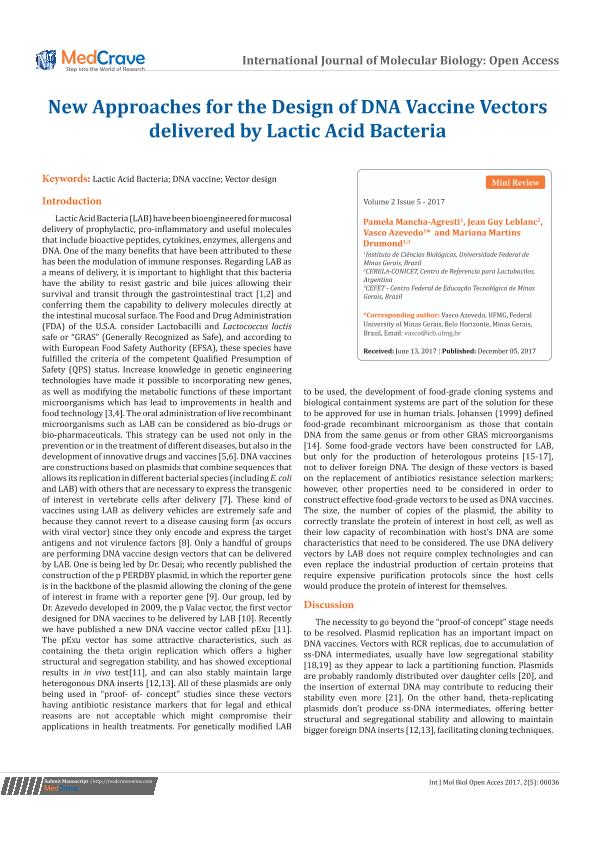Artículo
New Approaches for the design of DNA vaccine vectors delivered by lactic acid bacteria
Fecha de publicación:
05/12/2017
Editorial:
MedCrave Group
Revista:
International Journal of Molecular Biology
ISSN:
2573-2889
Idioma:
Inglés
Tipo de recurso:
Artículo publicado
Clasificación temática:
Resumen
Lactic Acid Bacteria (LAB) have been bioengineered for mucosal delivery of prophylactic, pro-inflammatory and useful molecules that include bioactive peptides, cytokines, enzymes, allergens and DNA. One of the many benefits that have been attributed to these has been the modulation of immune responses. Regarding LAB as a means of delivery, it is important to highlight that this bacteria have the ability to resist gastric and bile juices allowing their survival and transit through the gastrointestinal tract [1, 2] and conferring them the capability to delivery molecules directly at the intestinal mucosal surface. The Food and Drug Administration (FDA) of the U.S.A. consider Lactobacilli and Lactococcus lactis safe or "GRAS" (Generally Recognized As Safe), and according to with European Food Safety Authority (EFSA), these species have fulfilled the criteria of the competent Qualified Presumption of Safety (QPS) status. Increase knowledge in genetic engineering technologies have made it possible to incorporating new genes, as well as modifying the metabolic functions of these important microorganisms which has lead to improvements in health and food technology [3, 4].The oral administration of live recombinant microorganisms such as LAB can be considered as bio-drugs or bio-pharmaceuticals. This strategy can be used not only in the prevention or in the treatment of different diseases, but also in the development of innovative drugs and vaccines [5, 6]. DNA vaccines are constructions based on plasmids that combine sequences that allows its replication in different bacterial species (including E. coli and LAB) with others that are necessary to express the transgene of interest in vertebrate cells after delivery (Williams, 2013). These kind of vaccines using LAB as delivery vehicles are extremely safe and because they cannot revert to a disease causing form (as occurs with viral vector) since they only encode and express the target antigens and not virulence factors (Premenko-Lanier et al, 2004).Only a handful of groups are performing DNA vaccine design vectors that can be delivered by LAB. One is being led by Dr. Desai; who recently published the construction of the pPERDBY plasmid, in which the reporter gene is in the backbone of the plasmid allowing the cloning of the gene of interest in frame with a reporter gene [11]. Our group, led by Dr. Azevedo developed in 2009, the pValac vector, the first vector designed for DNA vaccines to be delivered by LAB [12] Recently we have published a now DNA vaccine vector called pExu [13]. The pExu vector has some attractive characteristics, such as containing the theta origin replication which offers a higher structural and segregational stability, and has showed exceptional results in in vivo test [13], and can also stably maintain large heterologous DNA inserts [14, 15]. The most common promoter and polyA signals used in DNA vaccine vectors are the constitutive human Cytomegalovirus (CMV) promoter and the bovine growth hormone gene because these increase transcription of mRNA that improves transgene expression (Williams, 2013).All of these plasmids are only being used in ?proof- of- concept? studies since these vectors having antibiotic resistance markers that for legal and ethical reasons are not acceptable which might compromise their applications in health treatments. For genetically modified LAB to be used, the development of food-grade cloning systems and biological containment systems are part of the solution for these to be approved for use in human trials.Johansen (1999) defined food-grade recombinant microorganism as those that contain DNA from the same genus or from other GRAS microorganisms. Some food-grade vectors have been constructed for LAB, but only for the production of heterologous proteins (Henrich et al., 2002, Leenhouts et al 1998; Simoes-Barbosa et al, 2004), not to deliver foreign DNA. The design of these vectors is based on the replacement of antibiotics resistance selection markers; however, other properties need to be considered in order to construct effective food-grade vectors to be used as DNA vaccines. The size, the number of copies of the plasmid, the ability to correctly translate the protein of interest in host cell, as well as their low capacity of recombination with host?s DNA are some characteristics that need to be considered. The use DNA delivery vectors by LAB does not require complex technologies and can even replace the industrial production of certain proteinsthat require expensive purification protocols since the host cells would produce the protein of interest for themselves.
Palabras clave:
Lactic Acid Bacteria
,
Dna Vaccine
,
Vector Design
Archivos asociados
Licencia
Identificadores
Colecciones
Articulos(CERELA)
Articulos de CENTRO DE REFERENCIA PARA LACTOBACILOS (I)
Articulos de CENTRO DE REFERENCIA PARA LACTOBACILOS (I)
Citación
Mancha Agresti, Pamela; Leblanc, Jean Guy Joseph; Azevedo, Vasco; Martins Drumond, Mariana; New Approaches for the design of DNA vaccine vectors delivered by lactic acid bacteria; MedCrave Group; International Journal of Molecular Biology; 2; 5; 5-12-2017; 154-156
Compartir




